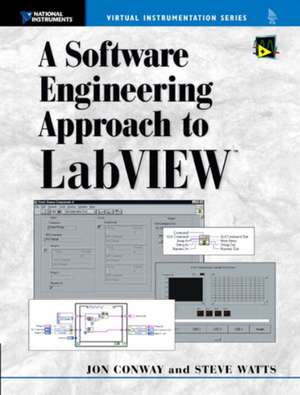A Software Engineering Approach to LabVIEW: National Instruments Virtual Instrumentation
Autor Jon Conway, Steve Wattsen Limba Engleză Paperback – 30 apr 2003
Preț: 495.15 lei
Preț vechi: 582.53 lei
-15% Nou
Puncte Express: 743
Preț estimativ în valută:
94.75€ • 99.38$ • 78.88£
94.75€ • 99.38$ • 78.88£
Carte indisponibilă temporar
Doresc să fiu notificat când acest titlu va fi disponibil:
Se trimite...
Preluare comenzi: 021 569.72.76
Specificații
ISBN-13: 9780130093653
ISBN-10: 0130093653
Pagini: 240
Dimensiuni: 178 x 236 x 16 mm
Greutate: 0.46 kg
Ediția:1
Editura: Prentice Hall
Seria National Instruments Virtual Instrumentation
Locul publicării:Upper Saddle River, United States
ISBN-10: 0130093653
Pagini: 240
Dimensiuni: 178 x 236 x 16 mm
Greutate: 0.46 kg
Ediția:1
Editura: Prentice Hall
Seria National Instruments Virtual Instrumentation
Locul publicării:Upper Saddle River, United States
Cuprins
Preface.
1. Introduction.
LabVIEW Sucks. Don't Buy This Book. The Soap Box. What This Book Is.
2. LabVIEW Rocks.
Why Does LabVIEW Rock? What Advantages Does This Bring to the Developer? How Can Good Design Leverage These Advantages?
3. Software Design Principles.
Why is Software Complex? Coupling and Cohesion. Information Hiding and Encapsulation. Examples of Coupling, Cohesion, and Information Hiding. Abstraction.
4. LabVIEW Component Oriented Design (LCOD).
Components. Design.
5. LCOD Implementation.
Component Mechanisms. Message Sending. Persistent Local Storage. The Basic Structure of a Component.
6. LCOD Complementary Techniques.
State Machines. Graphical User Interface (GUI) Design and Prototyping. (UI Controller..Message Queue Pattern). Abstraction in the Code, Detail Outside the Code. Error Handling. Pre- and Postconditions: Check What Comes In and What Goes Out. Reuse.
7. Software Engineering Essentials.
The Usual Suspects. Requirements Document. Quote/Project Validation. Target Specification. Test Plan. Software Architecture Document. Software Construction--Build. Test--Customer Acceptance. Pictures Tell a Thousand Words. Checklists. Code Reviews. The Project Is Dead, Time for a Postmortem. Metrics.
8. It's All About Style.
Why Do We Need Standards Anyway? Block Diagram. Front Panel.
9. The Journey.
Agreeing on the Destination (Requirements). Planning Your Route (Design). Build. Uh-Oh We've Been Given the Wrong Directions. Conclusions.
Glossary.
Index.
Other LabVIEW Books.
Notă biografică
JON CONWAY has 20 years' experience in writing software, with half of that in LabVIEW. His fieldsof expertise include real time, robotics, databases, DAQ, DSP, and multiple software languages andoperating systems; his idea for LCOD arose from his experience gained working on complex softwareprojects. Jon is a partner in Structured Software Design Consultants of Hampshire, UK.
STEVE WATTS has 15 years of experience in writing test software, and has been programming inLabVIEW for 6 years. His areas of expertise include OOD, the Yourdon methodology, CASE tools,electronics, lasers, switching system design, DAQ, statistical process control, databases, userinterface design, software engineering, as well as a variety of programming languages. Steve is apartner in Structured Software Design Consultants of Hampshire, UK.
STEVE WATTS has 15 years of experience in writing test software, and has been programming inLabVIEW for 6 years. His areas of expertise include OOD, the Yourdon methodology, CASE tools,electronics, lasers, switching system design, DAQ, statistical process control, databases, userinterface design, software engineering, as well as a variety of programming languages. Steve is apartner in Structured Software Design Consultants of Hampshire, UK.
Textul de pe ultima copertă
Create more robust, more flexible LabVIEW applications--through software design principles!
Writing LabVIEW software to perform a complex task is never easy--especially when those last-minute feature requests cause a complexity explosion in your system, forcing you to rework much of your code! Jon Conway and Steve Watts offer a better solution: LCOD-LabVIEW Component Oriented Design--which, for the first time, applies the theories and principles of software design to LabVIEW programming. The material is presented in a lighthearted, engaging manner that makes learning enjoyable, even if you're not a computer scientist.
- LCOD software engineering techniques make your software more robust and better able to handle complexity--by making it simpler! Even large, industrial-grade applications become manageable.
- Design to embrace flexibility first, making changes and bug fixes much less painful
- Pragmatic discussion of the authors' tried and tested techniques, written by--and for--working programmers
- Covers design principles; LCOD overview, implementation, and complementary techniques; engineering essentials; style issues; and more
- Complete with practical advice on requirements gathering, prototyping, user interface design, and rich with examples
- Work through an example LCOD project (all code included on companion Web site) to tie the lessons together
Descriere
The book will be written in a light-hearted and easily understood style, describing the LCOD design methodology. The latter half of the book will demonstrate the application of LC0D to an imaginary project, which is to develop an ATE.
